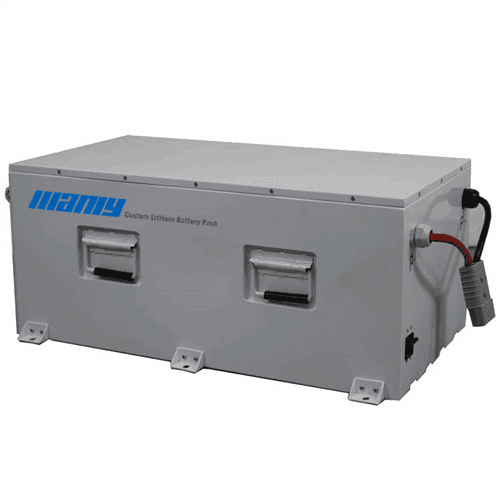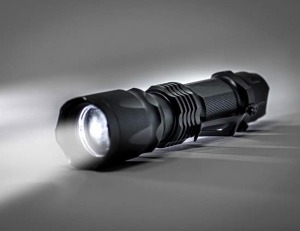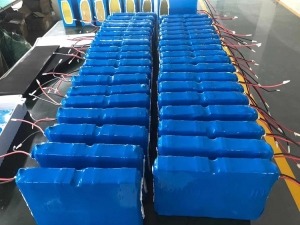Lithium Ion Forklift Battery vs Lead Acid: Comprehensive Guide
Table of Contents
- Lithium Ion Forklift Battery vs Lead Acid: Comprehensive Guide
- Lithium Ion Forklift Battery vs Lead Acid: Cost
- Lithium Ion Forklift Battery vs Lead Acid: Maintenance
- Lithium Ion Forklift Battery vs Lead Acid: Charging
- Lithium Ion Forklift Battery vs Lead Acid: Energy Usage
- Lithium Ion Forklift Battery vs Lead Acid: Other Differences
- Conclusion
- Learn More About Battery
Choosing the right forklift batteries is crucial for efficient warehouse operations. Among the options, lithium ion forklift batteries and lead acid batteries stand out. Each has unique features, costs, and maintenance requirements. Understanding these differences can help you make an informed decision that best suits your operational needs.
| Consideration | Lead Acid Batteries | Lithium-Ion Batteries | Winner |
| Cost | $5K to $12K | $17.5K to $25K | Lead-acid |
| Hours of Operation | 8 hrs in action; 8 hrs charging; 8 hrs cool down. Opportunity charging shortens life. | Capable of continuous operation with opportunity charging | Lithium-ion |
| Battery Life | 1,500 charging cycles | 2,500 to 3,000 charging cycles | Lithium-ion |
| Safety | Potential of acid spills. Toxic fumes generated during charging. Swapping out a 3,000 lb. battery can be dangerous. | Completely sealed. No toxic discharges during charging. No need to swap out battery | Lithium-ion |
| Maintenance | Battery must be topped up and equalized on a weekly or bi-weekly basis | Essentially maintenance-free | Lithium-ion |
| Power Level During Usage | Starts off strong but loses power during usage | Delivers close to rated power until 90% discharged | Lithium-ion |
| End of Life Disposal | Can be recycled. Extensive recycle industry developed | Recycling of Lithium-ion batteries still in its infancy | Lead-acid |

Lithium Ion Forklift Battery vs Lead Acid: Cost
Initial Purchase Cost
When considering forklift battery cost, it's important to compare the upfront expenses of lithium ion forklift batteries and lead acid batteries:- Lead Acid Batteries: The initial cost of a new lead acid battery ranges from $5,000 to $12,000, depending on the size and specifications.
- Lithium Ion Batteries: On average, a lithium ion forklift battery costs between $17,000 and $25,000. This is about 2-2.5 times higher than the cost of a similar lead acid battery.
Long-Term Savings
Despite the higher initial cost, lithium ion forklift batteries offer significant long-term savings:- Energy Efficiency: Lithium ion batteries are about 30% more energy-efficient than lead acid batteries. They also charge up to 8 times faster, reducing energy costs.
- Battery Lifespan: Lithium ion batteries last 2-4 times longer than lead acid batteries, translating to fewer replacements over time.
- Reduced Downtime: These batteries can be charged during operator breaks, eliminating the need for battery swaps and reducing downtime.
- Maintenance Costs: Lithium ion batteries require minimal maintenance compared to lead acid batteries, which need regular watering and maintenance checks.
- Operational Efficiency: Lithium ion batteries provide consistent power throughout their charge cycle, enhancing forklift performance and productivity.
Operational Costs
The operational costs of forklift batteries include more than just the purchase price:- Lead Acid Batteries: Require significant labor for maintenance, such as watering and charging, which increases operational costs. They also need a dedicated charging area, which takes up valuable warehouse space.
- Lithium Ion Batteries: Reduce labor costs as they don't require watering or regular maintenance. They can be charged anywhere, freeing up space previously used for charging stations.
Safety and Environmental Costs
Safety and environmental considerations also impact the overall cost of forklift batteries:- Lead Acid Batteries: Pose safety risks due to the potential for acid spills and toxic fumes during charging. These risks require additional safety measures and can lead to costly clean-ups and downtime.
- Lithium Ion Batteries: Are safer as they are sealed units with no risk of acid spills or toxic fumes. This reduces the need for stringent safety protocols and associated costs.
Lithium Ion Forklift Battery vs Lead Acid: Maintenance
Lead Acid Batteries
Lead acid batteries require frequent maintenance to keep them running efficiently. Here are the main tasks involved:- Watering: You need to fill each cell with water to maintain the electrolytes at optimal levels. For a standard single-shift operation, this should be done every week or at least every two weeks. Over-watering or under-watering can damage the battery, so it’s crucial to handle this process carefully and use the proper equipment.
- Semi-Annual Maintenance: Every six months, it’s necessary to check and control acid and corrosion levels. This includes inspecting for any defects and ensuring the electrolyte levels are above the separators. Keeping the vent caps tight is also important to prevent leaks.
- Storage and Temperature Management: When not in use, especially in winter, lead acid batteries should be stored in environments above 0°C. If the battery discharges 50%, the electrolyte can freeze, which can damage the battery. To prevent freezing, it’s best to charge the battery fully before storage.
Lithium Ion Forklift Batteries
Lithium ion forklift batteries require much less maintenance compared to their lead acid counterparts. Here’s what you need to do:- No Watering Needed: One of the biggest advantages of lithium ion forklift batteries is that they do not require watering, saving significant time and reducing maintenance costs.
- Regular Monitoring: It is still essential to regularly check for wear and tear on plugs and cables, monitor the charger for any faults, and keep the battery management software up to date.
- Temperature Control: These batteries should be kept at room temperature and away from moisture to avoid damage. They are sensitive to extreme temperatures, which can affect their performance and lifespan.
- Charging Practices: Avoid completely draining the battery. It’s best to recharge when the battery level is at about 15-25%. Partial discharges are recommended to prolong battery life.
- Storage Tips: If the forklift will be stored for an extended period, ensure the battery is charged to 80-90% capacity. Avoid storing the battery at 0% charge for long periods as it can harm the battery. In cold environments, it’s advisable to charge the battery in a place where the temperature is above 0°C.
Lithium Ion Forklift Battery vs Lead Acid: Charging
Table of lead acid vs lithium ion forklift battery charge time:| Lead-Acid | Lithium-Ion | |
| Use Time | 8 Hours | 8 Hours |
| Charge Time | 8 Hours | 1-4 Hours |
| Cool Time | 8 Hours | 0 Hours |
| Total Time Needed Before Use | 16 Hours | 1-4 Hours |
Charging Lead Acid Forklift Batteries
Lead acid batteries need careful charging routines to ensure their longevity and efficiency. Here are some key points:- Charging Cycles: Lead acid batteries can last about 1,500 charging cycles. This translates to roughly 3.5 to 5 years if charged once daily. However, with two or three shifts, each forklift requires at least two batteries due to the lengthy charging and cooling times, each taking about 8 hours.
- Avoid Overcharging: Overcharging occurs when the battery voltage exceeds the specified level, causing damage and potential safety risks. It's crucial to use a good quality forklift battery charger that matches the battery's voltage and amp-hour rating to prevent overcharging.
- Charging Routine: Lead acid batteries should be fully charged each time to maximize their lifespan. Partial charges can shorten their life, as each charge cycle counts towards the battery’s total lifespan.
Charging Lithium Ion Forklift Batteries
Lithium ion forklift batteries offer significant advantages in terms of charging efficiency and ease. Here are the main benefits:- Higher Efficiency: Lithium ion batteries have an efficiency that is 4-16 times higher than lead acid batteries. They typically last for 2,000 to 3,000 charging cycles, nearly double the lifespan of lead acid batteries.
- Fast Charging: Lithium ion batteries can be charged much faster, often within 1-2 hours. This efficiency reduces downtime significantly.
- Opportunity Charging: Unlike lead acid batteries, lithium ion batteries are not damaged by opportunity charging. This means you can charge the battery during breaks or between shifts without affecting its lifespan. This flexibility is especially beneficial in multi-shift operations.
- No Cooling Time: Lithium ion batteries do not require cooling periods after charging, further reducing downtime and increasing operational efficiency.
- Overcharging Prevention: Modern lithium ion batteries come with built-in management systems that prevent overcharging, enhancing safety and battery life.
Lithium Ion Forklift Battery vs Lead Acid: Energy Usage
Lead Acid Forklift Batteries
Lead acid batteries are widely used in forklifts, but their energy efficiency is limited. Here are the key points:- Energy Density: Lead acid batteries have an energy density of 80-90 Wh/L and a specific energy of 35-40 Wh/kg. This means they store less energy compared to lithium ion batteries.
- Energy Loss: These batteries are not good at retaining energy. They lose power while moving, charging, lifting, and idling. As a result, a forklift's performance diminishes throughout a shift. For example, a forklift might lift 3,500 lbs at the start of a shift but only manage 2,600 lbs after a few hours.
- Dedicated Charging Space: Lead acid batteries require removal from the forklift for charging. This means you'll need a dedicated space to store and charge the batteries, which can take up valuable warehouse space.
Lithium Ion Forklift Batteries
Lithium ion forklift batteries are more energy-efficient and offer several advantages over lead acid batteries:- Higher Energy Density: Lithium ion batteries have an energy density of 100-265 Wh/kg, making them 3-6 times stronger than lead acid batteries. This higher density allows them to store more energy, improving overall forklift performance.
- Constant Voltage: Unlike lead acid batteries, lithium ion batteries maintain a constant voltage level during their discharge cycle. This consistency can result in up to 50% energy savings compared to lead acid batteries.
- Opportunity Charging: Lithium ion batteries allow for opportunity charging, meaning you can charge them during breaks or between shifts without removing them from the forklift. This flexibility eliminates the need for a second battery and reduces downtime.
- Space Efficiency: Since lithium ion batteries do not require a dedicated charging space, you can repurpose this area for additional storage, improving warehouse efficiency.
Lithium Ion Forklift Battery vs Lead Acid: Other Differences
Lifespan
One key difference between lithium ion forklift batteries and lead acid batteries is their lifespan:- Lead Acid Batteries: Typically last for about 1,500 cycles. This means if you charge them once daily, they can last around 3-5 years.
- Lithium Ion Batteries: These batteries last between 2,000 to 3,000 cycles, nearly doubling the lifespan of lead acid batteries when properly maintained.
Safety
Safety is a major concern when handling forklift batteries. Here’s how the two types compare:- Lead Acid Batteries: These contain toxic substances like lead and sulfuric acid. They require weekly watering, which increases the risk of spills if not handled properly. During charging, they emit toxic fumes and can produce explosive gases if not stored in a controlled environment.
- Lithium Ion Batteries: These use a more stable chemical composition, typically lithium iron phosphate (LFP). They are fully sealed, meaning there is no risk of acid spills, corrosion, or toxic fumes. While they can still pose risks if damaged, they are generally safer than lead acid batteries.
Efficiency
Lithium ion forklift batteries are much more efficient than their lead acid counterparts:- Lead Acid Batteries: Lose energy constantly during use, charging, and even when idle. Their voltage drops gradually during the discharge cycle, reducing the forklift’s power over time.
- Lithium Ion Batteries: Maintain a constant voltage throughout the discharge cycle, providing more consistent power. This can lead to up to 50% energy savings compared to lead acid batteries. Additionally, they have about three times the energy storage capacity of lead acid batteries.
Weight
The weight of the batteries also differs significantly:- Lead Acid Batteries: These are heavy, typically weighing between 70-80 kg per usable kWh of capacity.
- Lithium Ion Batteries: Much lighter, weighing between 10-15 kg per usable kWh. This weight reduction can improve the overall efficiency and maneuverability of the forklift.
Recycling
Recycling capabilities of these batteries also vary:- Lead Acid Batteries: Almost all materials in lead acid batteries can be recycled. This makes them more environmentally friendly in terms of material reuse.
- Lithium Ion Batteries: These rely on more limited resources. While lithium is abundant, the recycling process for lithium ion batteries is more complex and less efficient compared to lead acid batteries.




















